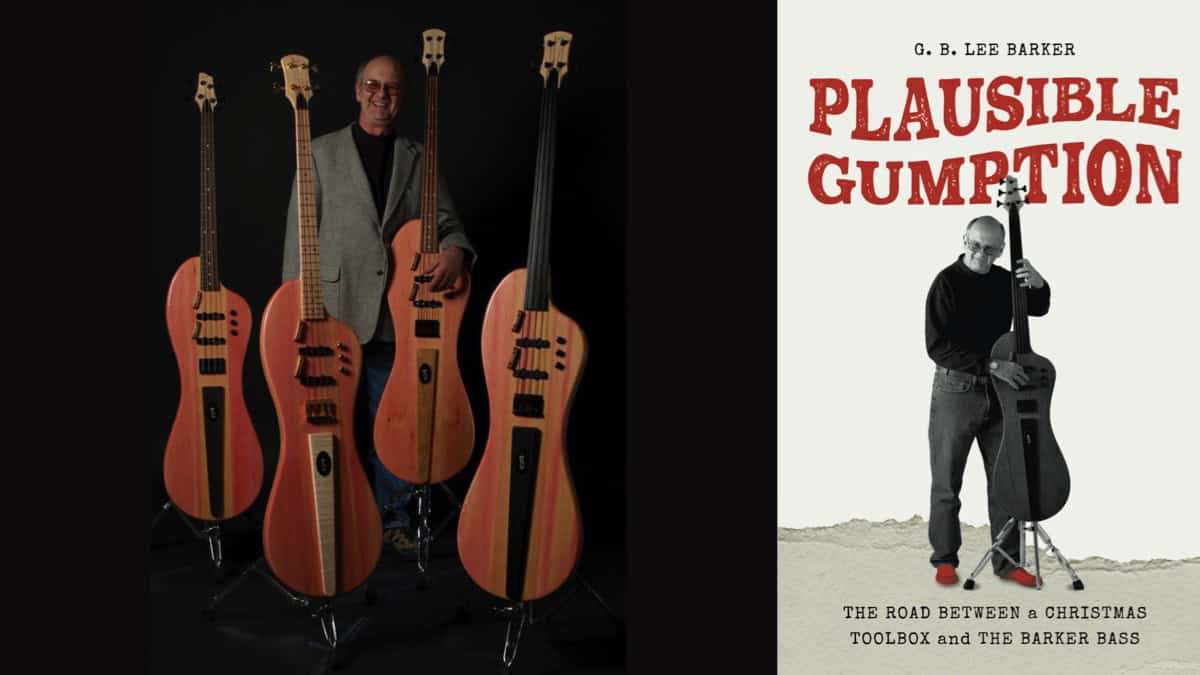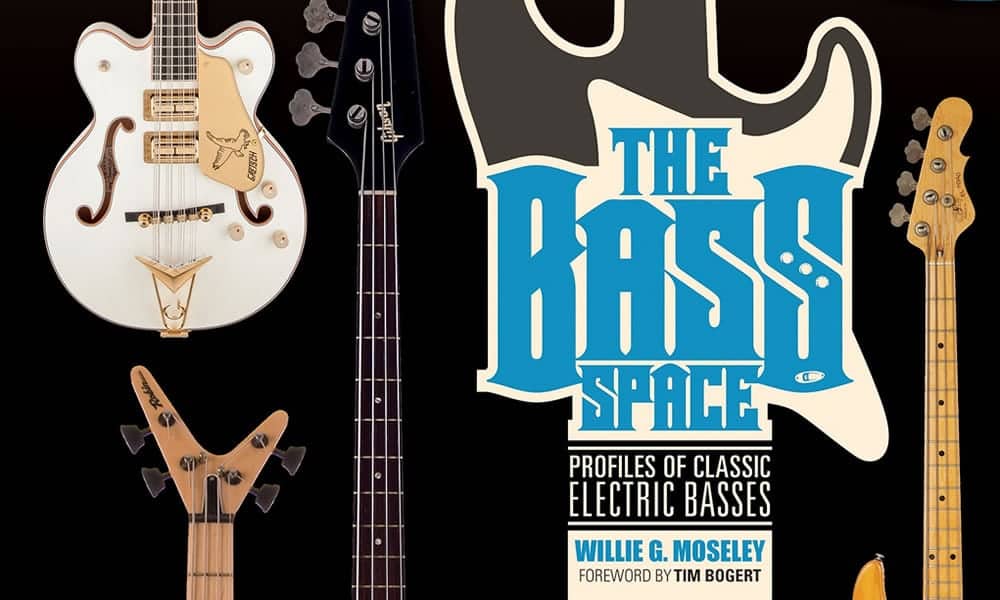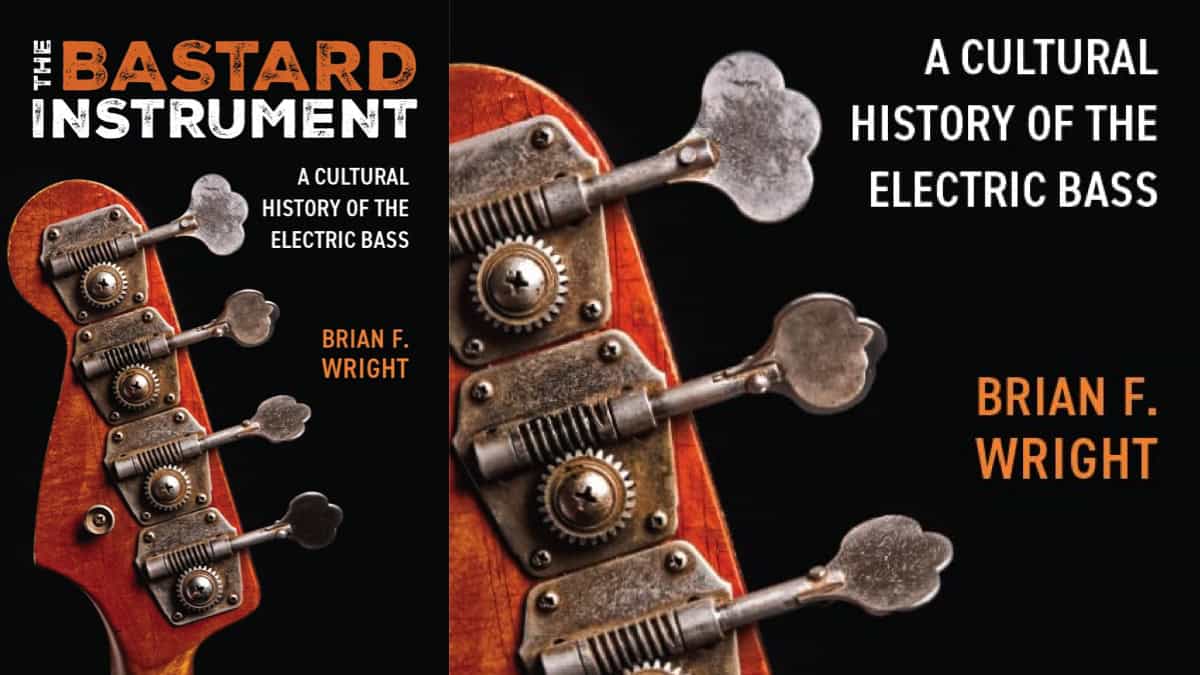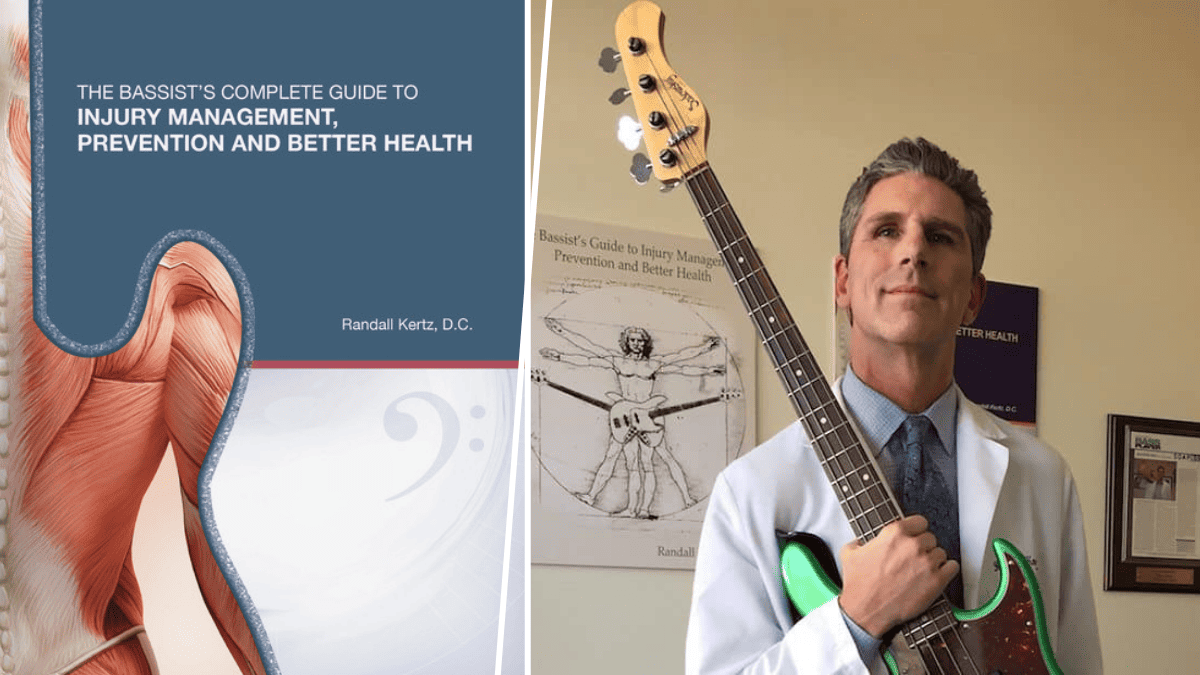Bass Books
Dan Hawkins: Taking it Online

Interview with bassist Dan Hawkins…
You may not know Dan Hawkins, but you’ve probably heard his work. Tim Fletcher catches up with a London-based bass player who has successfully embraced the online world.
Specialising in remote recording sessions from his home studio, Dan Hawkins has completed over one thousand tracks for clients in the UK, USA, Brazil, Canada, India, Egypt, France, Italy, Germany, Norway, Sweden, South Korea, Japan, Australia and Russia. He has recorded album sessions, jingles, adverts, movie soundtracks and film cues. His basslines have been featured on TV shows for Fox, ABC, VH1, Netflix, the BBC.
Dan Hawkins Sound Samples:
Dan is also a bass educator.
He runs an online teaching platform www.onlinebasscourses.com where he posts regular bass lessons, and his book ‘Creative Bass Technique Exercises – 70 Melodic Exercises to Develop Great Feel and Technique on Bass Guitar’ was published by Fundamental Changes in 2019.
Although much of Dan’s playing work is online, he has extensive performance experience including live work with Martha Reeves and the Vandellas, Rod Stewart, Katie Melua and Carla Bruni, and he has played for the West End production of ‘Les Misérables’.
Tim Fletcher: Hi Dan – How’s it going?
Dan Hawkins: Great thanks! An absolute pleasure to be here.
How have you dealt with the lockdown?
Well, in the UK where I’m based, there are NO gigs – they were all cancelled. The government has just opened pubs, and you’re allowed to travel on a crowded plane, but musicians aren’t allowed to work live just yet. But I have managed to do a lot of writing, creating lessons for my site, as well as doing plenty of remote sessions.
You do a lot of remote recording for clients around the world – has the lockdown impacted that at all?
The first ‘lockdown’ session I did was for a Netflix/BBC thing coming out later this year, and that came about due to the hired musicians not being able to go into the studio. Lockdown had literally just come into play, and the composer found musicians who could record remotely so he could finish the score. In general, things were quite slow at first when everyone around the world was getting used to their own personal situations, but now, I’ve noticed a fair few sessions coming in.
You’ve been doing this for about a decade now – how did you get into remote recording?
I always wanted to be a recording bass player, but I came into the industry just when the studio scene started to decline. Although studios were closing, the prevalence of great, affordable gear, and more musicians with their own home studios made it possible for remote recording to be a realistic alternative.
A friend of mine knew drummer Jon Howells who was already doing this, and I desperately wanted to join in – and it made a lot of sense for me to start something online. I was really excited about the opportunities presented online and the chance to hone my recording skills, whilst playing a wide variety of musical styles.
Your remote recording work has stretched across the world – How do you promote yourself to clients in different countries?
I was lucky in that I started over ten years ago. I tried to learn as much as I could about alien subjects like creating a website and search engine optimisation. By arriving quite early on the scene, I’ve managed to get my site high up on search engines for terms related to remote bass recording. I get lots of clients through just that to be honest.
I started out just by doing anything I could for whoever wanted bass, and trying to build connections – a bit like you would when trying to get into live work. Word of mouth comes into play as well and just trying to build up a lot of clients.
I assume the work is pretty varied?
Very varied. My clients range from bedroom enthusiasts to top TV composers and artists. I play a bit of double bass and I remember one day doing a nursery rhyme on upright followed by a very heavy metal track.
Sometimes you have no idea where your bass lines will end up. To my great surprise, I’ve randomly heard my playing several times on TV. I’ve played on demos, jingles, adverts, TV, film, albums, songs, and EPs. There are so many music creators out there.
Is it difficult to negotiate with clients, to be sure what they are looking for?
That’s a great question. Communication is definitely key online. Most of the time a client will be clear giving me references, a score, some instructions, a guide bass line, or some combination of those things.
Other times people say ‘just make it sound good’ – it’s always been a session player’s job to make the person whose music it is happy. Most of the time, they trust me to give them something that will work well. There are definitely people who have a strong idea of what they want, and people who don’t want to have to worry about the specifics. I’ll never start a session unless I really know what they want. It saves a lot of hassle that way.
What have been the most memorable projects you have worked on?
I’ve really loved playing on UK comedian Adam Buxton’s jingles and, during lockdown, I played on some for his audio book which was produced entirely remotely.
One that sums up the remote experience is a song I played on for Kuwaiti pop star Humood Alkhuder, produced by Egyptian musician Hamza Namira. Being from the UK I never heard the song Kun Anta’ here, but it did quite well in other parts of the world, and has had nearly 200 million views on YouTube.
Another one was a bowing double bass session I did for UK producer Matty Moon. Bowing on the double bass was not, and is not, my forté! I pretty much turned the session down but he convinced me to give it a go. A lot of practice and many takes later, I got it down, and I’m proud of the results. The track was a version of ‘Jaws of Hell’ by Lonely The Brave.
What would be your advice for bass players setting up a home studio for remote recording?
Spend your money on a decent DI and analogue/digital converters – I use a Universal Audio Apollo, which is great. You do need a good computer – I use Logic Pro with an iMac – and some basic DAW skills.
I do have lots of basses because I want to be able to cover any bass tone. I have vintage instruments by Fender, Gibson, Rickenbacker, MusicMan as well as a Hofner Club, MusicMan StingRay, a Lakland fretless, Zoot Funkmeister and a few others, but, honestly, just get a decent sounding bass set up well, with no buzzes.
I know that in ‘real’ studios I noticed a change in perception towards me when I started bringing a vintage Fender Precision. I reckon that’s a good bass to go for if you had to have just one bass for recording, but being able to provide a range of tones is helpful.
What are the main challenges that you might expect?
Being able to play enough styles well to get enough work is one. I love players like Carol Kaye, Leland Sklar, Will Lee, Nathan East, and in the UK, Steve Pearce, Andy Pask, Phil Mulford, and Trevor Barry, just to name a few. These are the kinds of bass players I admire the most – they can play anything, but what they provide is a great foundation for a song.
Apart from the playing side, being able to generate enough work is a challenge. That’s always been the case for every working musician, and online it’s no different. I like to earn my living by doing different things. I think of them as threads of income, and it’s a must to develop a business head to be able to keep money coming in, especially now.
Learning all the new skills you need is a major challenge. With all the resources out there it’s not difficult though; just not always easy to juggle everything.
You do some teaching too – is that online as well?
I taught one to one lessons in schools for fifteen years, but stopped that a couple of years ago to start my blog: www.onlinebasscourses.com. That’s probably where the majority of my time and efforts are focused now. I’ve started a YouTube channel and do at least one bass lesson a week. I absolutely love reaching passionate bass players around the world. The bass community is a really awesome place to be, and to be a small part of it is a real privilege.
I do the odd Skype lesson, but I create tons of free lessons for people – with the idea that a small and interested handful will buy my paid courses… when I get around to making them!
What’s the balance of your work currently?
The balance has really changed for me over the years. It used to be about 70/30 gigs/teaching, then the remote recording came in. In the last few years I probably do fewer gigs, but much more online teaching and remote sessions. The teaching side of things has really been about building the content on my site and my newsletter, so I haven’t earned anything from it yet, but will be able to soon.
For me, as much as I love gigs, I’d like to gain a steadier stream of income, and one that I’m in control of, so that’s more and more where I’m headed work-wise.
Which do you prefer?
Honestly, I love the balance and the variety. I have to say that it’s very hard to beat a great gig playing awesome music with friends. That kind of interaction can’t be replicated.
The online game is a solitary one, which suits me fine, but gives you the opportunity to take more control of your career and income. I really love that aspect of it – which for me beats having to wait for the phone to ring to get work!
Ultimately, being creative and earning money through bass playing is something that I’m truly grateful for. It’s the only job I’ve ever had and whilst sometimes it can be tough for various reasons, I love it.
I understand that you have played at Buckingham Palace for Queen Elizabeth II – was that a special day?
Yeah, that one was cool! And one of the best things about that gig was the journey. I’d just moved into a new flat closer to London, and this was my very first gig there – I just jumped on the Tube and was at the Palace within half an hour!
It was to celebrate the 60th anniversary of the Queen’s Coronation and a real honour to be a part of. I was playing for Katie Melua, and we played one song on two separate and very hot days. I remember playing and looking out from the stage onto the gardens. I saw a few of the Royals in the crowd (although I couldn’t see the Queen!) and thought that I’m lucky to do this as a job.
You have some great basses in your collection – which one is your ‘go-to’ bass?
If I had to pick one it would be my 1978 Fender Precision. That was my first vintage bass and, at the time, I was working with UK artist Luke Batt. He was recording an EP produced by Ken Nelson, who had recently worked with Coldplay. It was the first time an artist or producer really commented on my tone. Ken said it was one of the best P-bass tones he’d recorded. I got lucky with that one, as I got it for a reasonable price.
People feel very at home with what they know, and the look and sound of a Fender Precision pleases many. That was my first P-bass and I love it. That’s the bass that has been on the most sessions for me. It sits in the mix so well, has a very playable neck, and is so unfussy.
I also own a Lakland fretless that Pino Palladino played on a few tours and albums. That’s also a keeper.
Are there any basses you lust after?
Yes. How long have we got?! I absolutely love everything about the bass and consider myself a student of it, but I’m definitely not a collector. I only want basses I’ll actually use. A few that spring to mind are: a vintage Burns Bison, a Wal, and maybe a Sadowsky. I’m also amazed at how good some of the basses being made in the Far East are. I’ve been checking out a few of the Ibanez basses recently and they look great.
I’ve also always loved MusicMan and Warwick basses. In fact, my first proper bass as a kid was a Warwick Corvette Proline which was stolen. I’d like another one in my collection one day. I’ve built up my stable over the past 10 or so years, and I’m very happy with what I already have – there’s always room for more though!
Who are your major influences as a bassist?
One of my early teachers opened my ears to Jaco, and I became seriously obsessed for a year. I couldn’t listen to anyone else in that period. I also studied the ‘Standing in the Shadows of Motown’ book turning me onto James Jamerson, whose playing still blows me away.
At around the same time I got into Marcus Miller, Jimmy Haslip, Tony Levin, and John Patitucci through my music teachers. Through my older brother I listened to loads of rock, and Flea was a particularly big influence.
Other favourites are Saturnino, Victor Wooten, Carol Kaye, Pino Palladino (a huge influence), Stu Hamm, Bryan Beller, Herbie Flowers, Dave Richmond, Paul McCartney, Gail Anne-Dorsey, Guy Pratt, Laurence Cottle, Mark King and Geddy Lee. I’ll stop the list here knowing that I’ve missed out some of my absolute favourites.
Your book ‘100 Funk Grooves For Electric Bass’ was recently released – can you tell us a little about it?

It was written for a great publishing company called Fundamental Changes. I wrote it because funk music is very close to my heart, and there’s so much in the genre for bass players to learn from. It’s an ‘in the style of’ book, where I’ve written five bass lines each for twenty great funk bassists, split into different sub-genres.
Each chapter starts off with a bit of history, the gear that was used, and key songs to check out. The book comes with a twelve-hour playlist, audio examples, 100 pro-recorded drum loops, a few backing tracks and a few video lessons.
I also give plenty of tips on how to make up your own bass lines and fills. I think it’s really important to take whatever you’re learning and apply it in real-world musical situations. I try my best to give as many real-world bass playing tips as I can.
Dan’s book ‘100 Funk Grooves for Electric Bass’ is available now at fundamental-changes.com | Click here to download a sample
You cover the styles of some great funk bass players in the book – who is your favourite funk bassist?
That’s a tough one, although Bernard Edwards springs to mind! His combination of muscular tone, beautifully perfect hook-based lines, and ferocious technique is hard to beat. His timing is out of this world.
I do have to mention a couple of the Prince bass players: Ida Nielson and Rhonda Smith. There weren’t many female bass players in the classic bands and eras I featured in the book, but it’s great to see so many incredible female bass players around now.
Have you written any more bass tuition books?
Another Fundamental Changes book is ‘Creative Bass Technique Exercises’. I like literal titles! This book works on many different aspects of music, through examples that actually sound like real bass playing. I’m very proud of it. There are many more titles to come in the future.
What’s your next project?
After moving to Singapore next month, I’ll be writing my next book (a technique one), creating some courses for my site, more remote sessions, growing my YouTube channel, and trying to find some gigs in a new town! I’m also setting up a bass and drum loops website with Jon Howells, who I mentioned before.
Playing live is a real part of my identity, and I definitely want to keep improving on that front, so I’ll be looking for live music opportunities in Singapore and the surrounding area.
Thanks for your time!
My pleasure!
Bass Books
Interview With Barker Bass’s Inventor and Writer Lee Barker

If you are an electric bass player, this is an exciting time to be alive as this relatively new instrument evolves around us. Some creative individuals have taken an active role in this evolution and made giant leaps in their own direction. Lee Barker is one of these inventive people having created the Barker Bass.
Fortunately, Lee is also an excellent writer (among so many talents) and has recently released his book “Plausible Gumption, The Road Between a Christmas Toolbox and The Barker Bass”. This book is a very fun read for everyone and shares a ton of details about Lee’s life in general, his experiences as a musician, a radio host, and a luthier. Now I am fortunate to have the great opportunity to gain even more insights into this renaissance man with this video interview.
Plausible Gumption, The Road Between a Christmas Toolbox and The Barker Bass is available online at Amazon.com
Bass Books
Ultimate Look at Electric Basses from 1930 to Today

The Bass Space: Profiles of Classic Electric Basses.
The definitive book for lovers of the low-end. Willie G. Moseley, Senior Writer for Vintage Guitar Magazine, profiles more than 100 historic and unique electric bass models from such makers as Alembic, Danelectro, Fender, Gibson, Gretsch, Guild, Hamer, Kramer, Rickenbacker, and many others.
Rare and legendary instruments, from the earliest attempts at amplified basses in the mid-1930s to the cutting-edge instruments of today, are presented in more than 250 color and period photos.
The main feature of this book is the exclusive coverage of historic and one-of-a-kind basses owned and played by such famed musicians as: Bill Black (Elvis Presley), Tim Bogert (Vanilla Fudge), Mark Egan (Pat Metheny Group), John Entwistle (The Who), Paul Goddard (Atlanta Rhythm Section), Bruce Hall (REO Speedwagon), Greg Lake (Emerson, Lake & Palmer), Benjamin Orr (The Cars), Tom Petersson (Cheap Trick), Carl Radle (Derek and the Dominos), Gene Simmons (Kiss), Steve Wariner, and others.
The Bass Space: Profiles of Classic Electric Basses is available online at Amazon.com
Bass Books
Review: The Bastard Instrument, A Cultural History of the Electric Bass by Brian F Wright

I was intrigued when The Bastard Instrument showed up on my desk… let’s dig in!
When we dive into the history of our beloved instrument, the bass, we find roots that go back as far as the 15th century. This instrument was a member of the violin family and was for the longest time, an acoustic instrument. As the years passed and music changed, there was a need for the instrument to evolve and the electric bass was born.
Comparatively, the electric bass is a relatively new instrument with its earliest appearances dating back to the 1930s and it is exciting to be an electric bass player while this history unfolds around us. Fortunately for us and future generations to come, Professor Brian F. Wright has taken on the herculean task of documenting the trajectory of the electric bass with this excellent book.
The Bastard Instrument presents an extraordinary amount of fine details about the instrument itself, the development of the amplification to handle its output, the pioneers that dared play it, the rapidly evolving music that flourished because of its presence and so much more.
When I first started reading this book, I noticed that it felt a tad academic, like a textbook (it might be one someday) or a doctoral thesis, but to present all this information accurately, this approach is more than appropriate. Another detail that might be a bit of a spoiler is that the book only gets us up to the late ’60s. I was left wanting more as we know that so much has happened in the bass world since that time frame; I hope there is another volume in the works to get us up to the present!
All in all, “The Bastard Instrument, A Cultural History of the Electric Bass” is a must-read for all of us who play electric bass and understand its essential place in music.
I found that there was a lot that I already knew but also quite a bit that I was unaware of. I believe that to know and understand where you are, you must know the history of exactly how you got here.
Highly recommended.
The Bastard Instrument is available at Amazon.com (beginning July 2024)
Bass Books
Review: The Bassist’s Complete Guide to Injury Management, Prevention and Better Health

The Bassist’s Complete Guide to Injury Management, Prevention and Better Health
I have often thought that it would be great if the doctors who delivered us as newborn babies provided us with a user manual to help us navigate through life in the best way possible. Now Dr. Randall Kertz, D.C. has produced a manual specifically designed to address the many possible afflictions plaguing us bass players.
Many of you will remember volumes 1 & 2 of this book and our first review in 2007. The new complete guide combines the two volumes and features over 20 pages of new material including interviews, techniques, and conditions.
If you play bass, you can read this book cover to cover and walk away with a ton of relevant and helpful knowledge. Another option is to search out issues relevant to you specifically (I found quite a few of my own with helpful options). This is possible because the book is very nicely organized into six chapters that address Pain, Conditions, Techniques, Road Issues, Inspirational Q&A with some of the biggest names in the bass community (too many to list here) and finally How to get relief.
All said, this book is essential if you play either electric or upright bass to the point where they should issue you one when you get that first bass in your hands.
Lastly, if you have this book and you have specific questions, Dr. Kertz is readily available through his website, www.drkertz.com. As if that was not enough, he has a wealth of knowledge you can find right here on our website at bassmusicianmagazine.com/author/randallkertz
Get this book… Live long and play bass well into the years! Available on Amazon.com
Bass Books
The Bassist’s Complete Guide to Injury Management, Prevention & Better Health

The Bassist’s Complete Guide to Injury Management, Prevention & Better Health is now available!

A compilation of Volumes 1 & 2 of the acclaimed Bassist’s Guide with 20+ pages of new interviews, techniques, and conditions, The Complete Guide puts everything in one convenient place.
Available at Amazon.com and from our friends at Bassline Publishing
Follow Dr. Kertz’s Bass Player Health at Bass Musician Magazine





